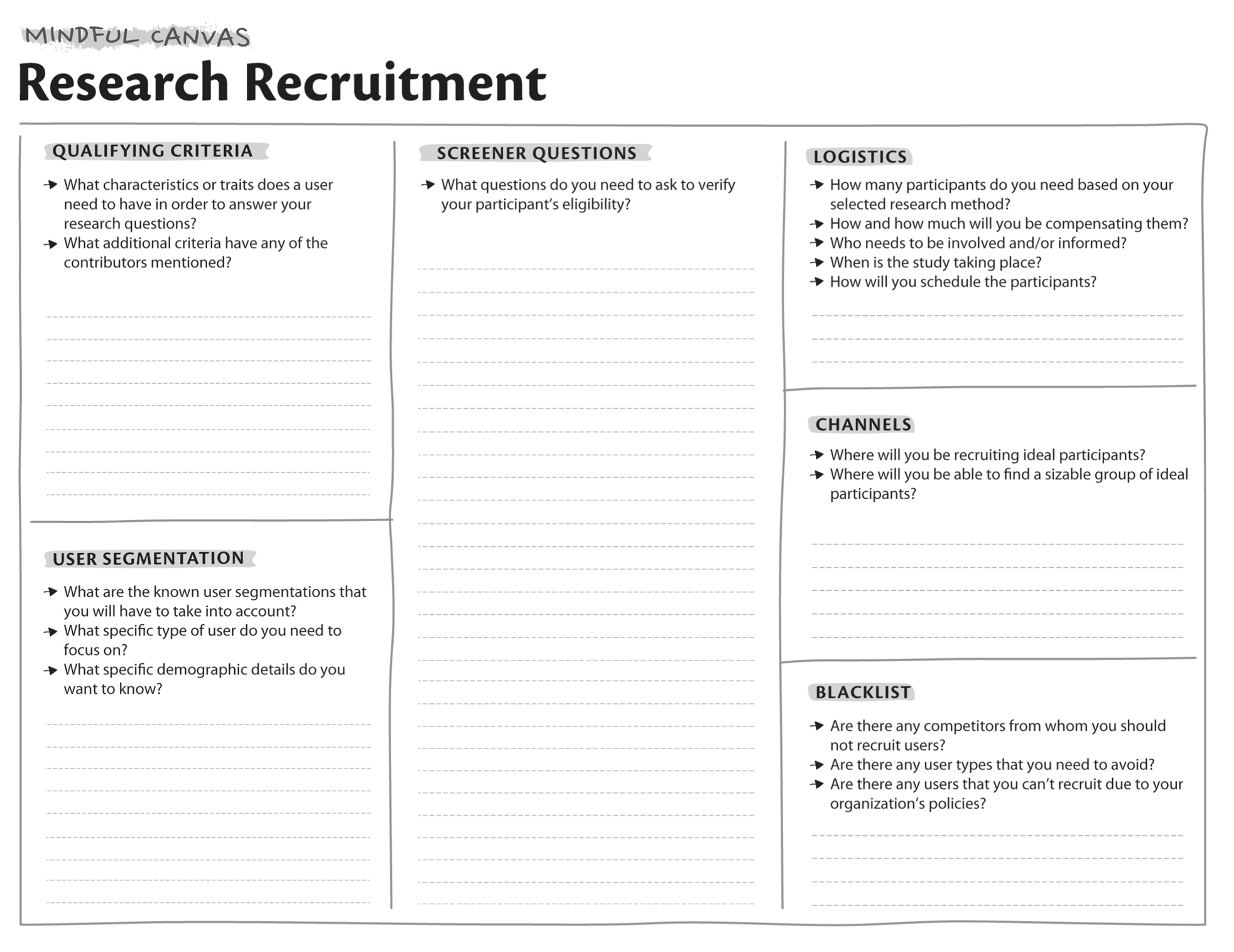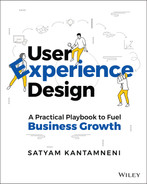CHAPTER 26
RESEARCH RECRUITMENT PLAY: How do I recruit the right participants for user research?
Identifying and recruiting the right participant for your study is the foundation for research success. Recruiting the wrong participant or selecting only a partial match will diminish the quality and breadth of insights that you gather. The research recruitment play will help you define participant screening criteria, plan recruitment logistics, and mitigate potential liabilities.

Who Are the Key players in the Research Recruitment play?
| ROLE | WHO’S INVOLVED | RESPONSIBILITIES |
|---|---|---|
 DRIVER |
|
|

CONTRIBUTOR |
|
|

THE HOW
To run an effective research recruitment play, you need to be mindful of:
1. The QUALIFYING CRITERIA for Your Ideal Participant
Work with your peer practitioners to identify your research goals to determine the type of user you need to speak to and the qualities they need to have. Think through what the ideal user should know, be able to do, and what their context or environment should be like in order to answer your research questions.
Create a list of qualifying criteria to ensure that the right set of participants can be screened from a larger pool of candidates.
Typical criteria could include items such as (but not limited to):
- Occupation;
- Language spoken;
- Familiarity to specifics tools or methods;
- Type of tasks they handle;
- What context should be exposed to;
- What features and products do they use.
Note that the more criteria you have, the more difficult it will be to recruit, however, it would result in more accurate insight..
2. The Different USER SEGMENTS You Want to Assess
Unlike qualifying criteria, which either select or eliminate participants from the study, segmentation categories are nice‐to‐knows that can give you more context on your participants and help you eliminate selection bias.
One way to identify segmentation categories is to determine the different types of use cases your product supports. For example knowing the industry your participants represent can help produce a more distributed sample that represents more of these use cases.

Segmentation categories are also useful for identifying category‐specific trends during synthesis, further down the research process. You may find that certain segments have needs or pains that are not present in other segments.
3. The SCREENER QUESTIONS You Use to Recruit Participants
Use the participant criteria and segmentation categories you identified as a foundation for creating your screener survey. Screener surveys will contain questions that are designed to help you find participants who meet your criteria and sufficiently determine whether their responses are honest.
Your screening questions should be specific enough for you to confidently define a match but also vague enough to prevent respondents from easily guessing exactly what you’re looking for.
The screener should not be used as a way to answer your research questions. All insight gathering should take place during the actual research session.
4. The LOGISTICS of Recruitment
Once you know what research method you are recruiting for (Chapter 25: “Picking a Research Method Play”) and have the participant screener prepared, start planning the logistics of screener distribution and internal and external communication.
- Sample size: The number of participants you need will determine which channels you use to source your participants. Larger sample sizes may require the help of recruitment platforms or services.
- Recruitment complexity: Niche user types, including specialized professionals, are more difficult to recruit than “gen pop” (general population) audiences and may also require you to use recruitment platforms and services.
- Participant compensation: You should always compensate participants for their time. The minimum hourly participant compensation should be equal to or greater than the average hourly rate for their role. Disclose the compensation amount and method (example: PayPal, gift card, check, in kind) in your screener.
- Informed and involved stakeholders: In addition to researchers, designers and product managers may want to be involved in the studies. Other departments, such as legal or finance, may need to manage compliance or payment‐related tasks.
- Time frame: Establish clear start and end dates for the study.
- Scheduling: Most recruitment platforms already have scheduling capabilities. If you are not using one of these platforms, establish an alternative way to coordinate availability, such as an online calendar where participants can select available time slots.
5. The CHANNELS You Recruit Through
Depending on the number and type of participants you need, it may be necessary to choose more than one channel for recruitment.
Keep budgeting and operational constraints in mind, because the channel(s) you choose may affect:
- How you launch your screener;
- How you pay your participants;
- How you schedule your participants;
- The total spend for recruitment.
If you are reaching out to participants through community groups or forums, always make sure you are aware of their policies on recruiting before posting your screener.
6. The Recruitment BLACKLIST
Once you know what research method you are recruiting for (Chapter 25: “Picking a Research Method Play”) and have the participant screener prepared, start planning the logistics of screener distribution and internal and external communication.
Before launching your recruitment, define your blacklist criteria: the types of participants you should not recruit. While this may seem counterintuitive, creating a blacklist can mitigate liability for your company.
When in doubt consult with a legal team or cross‐check your company policies to find out whether there are any other possible liabilities.
Once you’ve finished these steps, distribute your screeners and check your pipelines frequently.
IN ORDER TO MAXIMIZE THE VALUE OF THIS PLAY
- Identify and eliminate potentially unmotivated participants.
Motivated participants are individuals who understand the use cases of the study, are eager and willing to share their insights, and are not driven by pressure from their superiors or by monetary compensation.
Motivated participants feel that it is in their best interest to share their insights.
Unmotivated participants are individuals who may have been forced by another peer to participate, or who simply want the incentive. They are not driven to give you the best help they can.
- Over‐recruit so you have backups. It’s good practice to recruit more qualified participants than you need. This provides a buffer if some respondents do not accept your invitation, or if others provide poor insights.
- Invest in a panel of participants. Manage a ready‐made panel of users who have given explicit consent to have their contact information stored to receive research opportunities. The panel should represent a wide range of users, and researchers can invite participants who meet each study’s qualification criteria.
- Start recruitment early: We recommend starting recruitment at least two weeks before you begin the study.
 RELATED PLAYS
RELATED PLAYS
- Chapter 25: “Picking a Research Method Play”
